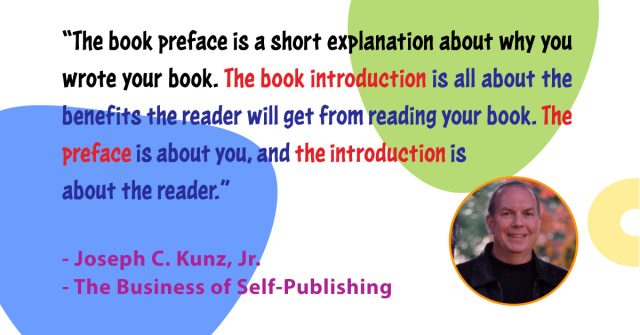Podcast: Play in new window | Download
Subscribe: Apple Podcasts | Spotify | Pandora | RSS | More
Updated September 15, 2023
Subtitle
How to write a preface that will make you look like a pro and sell more books
Synopsis
The preface is an important marketing tool to help you connect emotionally with the reader. This bond will translate into more sales and help give your book a longer life span.

What You Will Learn
1. You will learn why the book preface is in a book.
2. You will learn the basic structure of a preface.
3. You will learn why you must use the preface to help you develop an emotional connection with the reader.
Introduction
The preface is an important marketing tool to help you connect emotionally with the reader. Many are confused about the preface and why it is in a book. But once they understand the how, what, when, where, and why of the function of the preface, they will appreciate its role in making the book complete.
The more the reader understands you, can identify with you, and has formed some emotional bond with you, the more they will enjoy and learn from reading your book. This bond will translate into more sales and help give your book a longer life span.
Here Are Three Questions That Will Help You Create a Fantastic Preface:
Question #1: What Is The Preface? And What’s Its Purpose?
The book preface (PREF-iss, not PRE-face) briefly explains why you wrote your book. The book introduction, however, is all about the benefits the reader will get from reading your book. In other words, the preface is about you, and the introduction is about the reader.
But the book’s author should write both, and both must show your passion and make an emotional connection with the reader. In contrast to the preface and introduction, the author does not write the book’s foreword. A guest author writes the foreword. This author is typically a well-known person within a particular industry who can bring third-party credibility to you, the book’s author.

Question #2: What Is the Structure of the Preface?
The preface discusses the story of how your book came into being or how the idea for your book was developed by you, the author. To be a successful marketing tool, it must show your passion for the subject matter and your inspiration for writing the book.
Here’s your chance to infect the reader with your passion for the topic you’ve written about. You aim to make the reader empathize with you and identify your genuineness in writing the book. Show the reader you are a kindred spirit with a shared passion.

You Should Answer Questions Such As:
1. How was the concept of the book born?
2. How did you think of writing the book?
3. Why are you writing about this topic?
4. What are you trying to achieve by writing this book?
5. What are your qualifications to write this book?
6. What other books have you written?
7. Why are you writing this book now?
8. What was your primary source of inspiration?
9. Why did you re-write this book?
So, What’s the Bottom Line?
The bottom line must be, “Why did you write this book?” The explanation of these questions can be autobiographical. You can tell the background, the context, and the circumstances that brought you to write this book. Be transparent and honest about this: no exaggeration or puffery. Always write in the first person and a friendly manner. Also, use your own unique voice when writing this way and speak directly to your audience.
FUN FACT: The word ‘acknowledg(e)ment’ is typically spelled with this extra letter e outside the US and Canada. We usually don’t use that extra letter e in the US and Canada. Not all spellcheck programs will catch this since both are technically correct. -JCK
Question #3: How Do I Close The Preface?
A statement of thanks and acknowledgments to helpful people follows the main body of the preface. The author should add an acknowledgments section if the list is too long,
Alternatively, some authors use both sections within the book and the acknowledgments page for the most special contributions. And the lesser contributors are kept in the preface. Another alternative that some authors use is to combine the preface and the introduction into one section and label it as the introduction. Finally, the author signs the book preface and the date and place of writing.

Conclusion
Now that you better understand the preface, you can see that it wasn’t as difficult to understand or write. Remember, the preface is one of the important places for you to make an emotional connection with the reader.
Don’t waste this prime opportunity to help the reader better understand you and your book. The more the reader understands you, can identify with you, and has formed some emotional connection with you, the more they’ll enjoy and learn from reading your book. This bond will translate into more sales and help give your book a longer life span.
Questions to Think About
1. What are the topics you discussed in your book’s preface?
2. How do you, the book, and the reader benefit from what you discussed in your preface?

